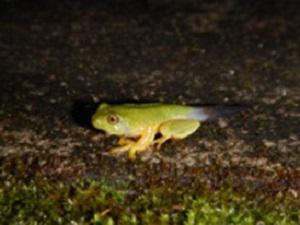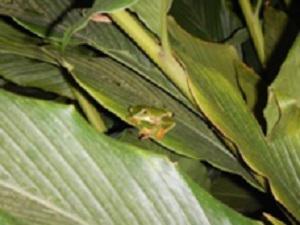Monica Harpalani
The project aims at enhancing the conservation of amphibians inside shade grown coffee and cardamom plantations by conducting habitat restoration, building permanent and promoting organic farming among stakeholders.

A metamorph of Rhacophorus pseudomalabaricus in a tank.
The Cardamom Hills of southern Western Ghats comprise of tea, coffee and cardamom plantations interspersed with fragments of primary forests. The landscape provides a habitat for numerous endemic amphibians such as the Critically Endangered Anamalai gliding Frog. This arboreal species is known to utilize under canopy vegetation and stagnant pools of water to build foam nests in the breeding season. Post its description in 2000, it was believed that this frog prefers primary rain forest and does not occur in degraded forests. However, evidence from grey literature suggests its occurrence inside abandoned cardamom plantations from different locations providing new distribution records.

Adult male of Rhacophorus pseudomalabaricus.
The project aims to understand the geographical distribution of Anamalai gliding frog in the Cardamom Hill landscape, both inside and outside the protected area network. Habitat characterization will be conducted in the species’ habitat to understand its requirements; viz. altitude where it occurs, the kind of vegetation it utilizes as habitat, parameters of the pools where it breeds and builds foam nests. Additionally, surveys will be conducted in shade grown coffee and cardamom plantations to ascertain the extent of usage of these estates by the threatened frog. The owners of the estates where the species occurs will then be invited to attend workshops on organic farming where they will be provided with cost-benefit reports of organic versus inorganic farming, contacts of organic farming practitioners and procedure of organic certification. Interested planters will be encouraged to demarcate pesticide free zones in a part of their land. Secondly, permanent water tanks will be constructed in the estates where foam nests are encountered, thereby providing an additional water source to the owners and increasing the breeding habitat of the target species. Habitat restoration will be taken up focusing on under canopy reconstruction in order to mitigate the problem of canopy discontinuity inside plantations that these frogs face.
The project aims at improving the habitat of these amphibians in shade grown coffee and cardamom plantations that fall outside the protected area network. The protected areas located in and around the town of Munnar in Kerala will be surveyed to understand the distribution and abundance of the target species in addition to its habitat requirements. Habitat characterisation of these areas will be aimed to understand the kind of vegetation utilized by this under-canopy dwelling species to build foam nests. Shade grown coffee and cardamom plantations will also be surveyed for the presence of Anamalai Gliding frog. The owners of the plantations where the species is found, will be invited to attend discussions and workshops on organic farming. Attempts will be made to convince interested planters to set aside pesticide free zones in their estates thereby encouraging them to adopt organic farming. Additionally, the plantations where the species is spotted making foam nests Habitat restoration will be conducted.